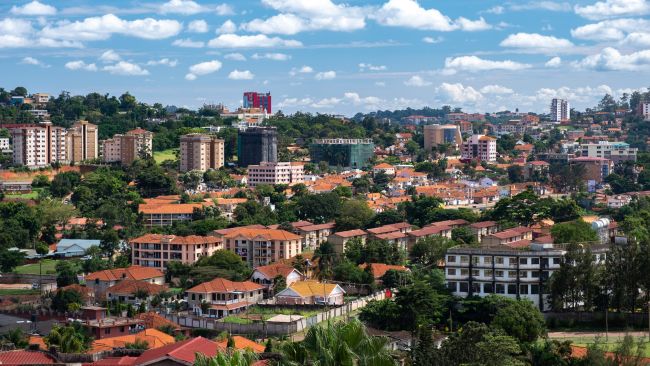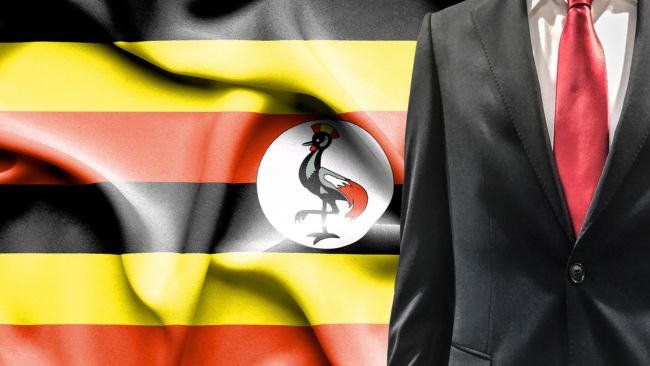Uganda’s Culture, Language, Customs, and Traditions

Uganda, situated in east-central Africa, has a land area comparable to Great Britain and is inhabited by many ethnic groups. Despite this diversity, the English language and Christianity serve as a unifying force among the people. The cosmopolitan capital, Kampala, with its many parks, public gardens, and a beautiful promenade along the shore of Lake Victoria, Africa’s largest freshwater lake, serves as a hub for bringing people of different backgrounds to the region.
The Swahili language helps connect Uganda with its neighboring East African countries of Kenya and Tanzania. Uganda became formally independent on October 9, 1962. Still, its borders, somewhat arbitrary during the late 19th century, encompass two distinct types of societies: the relatively centralized Bantu kingdoms of the south and the more decentralized Nilotic and Sudanic peoples in the north.
Population
 As of the latest available data, the estimated population of Uganda is 48,165,745. This figure places Uganda as the world’s 31st most populous country.
As of the latest available data, the estimated population of Uganda is 48,165,745. This figure places Uganda as the world’s 31st most populous country.
The population of Uganda has been steadily increasing over the years. In 1960, Uganda’s population was approximately 6.8 million, which has tripled over the last six decades. Uganda’s population growth rate is estimated at 3.3%, one of the world’s highest.
Uganda’s population comprises many ethnic groups, with no particular group dominating the population. The most common ethnic groups are:
- The Baganda are the largest ethnic group in Uganda, with an estimated population of approximately 3.9 million people, which accounts for around 17% of the country’s total population. They are primarily located in the country’s central region, their traditional homeland being the Buganda Kingdom.
- The Basoga are the second-largest ethnic group in Uganda, with an estimated population of around 1.8 million people, which accounts for about 8% of the country’s total population. They are primarily located in the country’s eastern region, with their traditional homeland being the Busoga Kingdom.
- The Bagisu are another significant ethnic group in Uganda, with an estimated population of just over a million people, which accounts for around 5% of the country’s total population. They are primarily located in the eastern part of the country, with their traditional homeland being the foothills of Mount Elgon.
Religion
Uganda’s religious heritage is diverse and complex, consisting of three main religions: indigenous religions, Islam, and Christianity. The vast majority of Ugandans, about four-fifths of the population, are Christians, with Roman Catholics and Protestants comprising the largest denominations. The Protestant community comprises Anglicans, Pentecostals, Seventh-day Adventists, Baptists, and Presbyterians. Around one-eighth of the population is Muslim, while the remaining minority practices traditional religions.
While Christianity and Islam dominate Uganda’s religious landscape, there are also small communities of Jews, Sikhs, and Hindus. The Abayudaya Jews are descendants of converts to Judaism in the 1920s and live in communities in eastern Uganda. Until 1972, when Asians were expelled from the country, many Sikhs and Hindus lived throughout Uganda. In recent years, with the return of South Asian practitioners, Sikhism and Hinduism have been re-established in the country.
National and Local Languages of Uganda
English is the official language of Uganda and is widely spoken by educated Ugandans. This is due to Uganda’s history as a British colony and subsequent membership in the Commonwealth of Nations. English is used in government, business, education, and other formal settings throughout the country.
Uganda has a diverse range of indigenous languages, which can be classified into three major language families:
- Bantu: Bantu languages are the most widespread, spoken by over two-thirds of the population, and include languages such as Luganda, Runyankole, and Runyoro.
- Central Sudanic: Central Sudanic languages are spoken in the northern part of the country and include languages such as Acholi, Lango, and Alur
- Nilotic: Nilotic languages are spoken in the northeastern part of the country, including languages such as Ateso, Karamojong, and Kumam.
Other indigenous language speakers located in the northern and eastern parts of the country use Swahili as their lingua franca.
Family Life in Uganda
Ugandan families are large, just like families in other African societies. It is common to see aunts, uncles, and grandparents living together in one household. Males make the key decisions in the Ugandan household, and women are meant to rely on their decisions.
This dependence deprives women of influence in family and community matters, tying them to male relationships for sustenance and their children’s survival. That is why it is more likely to see males dominating the business space in Uganda.
Every family member contributes to a child’s upbringing, and they are usually the first to introduce a child to the Ugandan language, customs, and culture.
Arts and Architecture in Uganda
In recent years, Ugandan architecture and art have grown tremendously. When you visit Uganda today, you will see several unique and modern projects representing the country’s artistic conditions. Uganda is filled with innovative and skilled architects who develop buildings with uncommon materials. The architecture of Uganda exhibits a particular blend of traditional and modern features, as well as the imagination and talent of its architects and constructors.
In Uganda, you will discover the following forms of art and architecture:
- Bark Cloth: The Buganda Tribe of Uganda makes a traditional cloth called Bark Cloth out of Mutuba Tree bark. This fabric has a long history of usage in ceremonial dress, particularly at coronations and funerals. It is also used in the creation of purses and magnificent artwork. Peeling the bark, boiling it, beating it with a hammer, stretching it, and letting it dry are all steps in the production process. To protect the tree, it is carefully wrapped after harvesting, allowing it to be harvested the next year.
- Basketry: Baskets may be seen practically anywhere in Uganda. In Uganda, the traditional basket weaving technique is coiling, which includes building a circle foundation and then weaving around it. This adaptable technique can be mastered by novice and professional weavers. Warp Twining is another way of constructing these baskets, in which the weaver selects spokes and materials and then weaves them around the spokes.
- Beadwork: Beadwork is a traditional art form in Uganda. For a Ugandan, each bead is special. The material used is bright glossy paper, commonly magazine pages or wall poster paper. The majority of beadwork in Uganda is done by women artists. They utilize this to achieve financial freedom.
Ugandan Food
In Uganda, a small percentage of people in urban centers do not cultivate their own food; most individuals do so in rural regions. Men and boys above the age of 12 are often not permitted in the kitchen. Women and girls in the household are responsible for making meals. Usually, food is prepared over an open flame using wood as fuel. The majority of Ugandan families eat lunch and dinner. Breakfast is often comprised of a cup of tea or a bowl of oatmeal. Everyone in the home is required to wash their hands before eating. Hands are sanitized before and after meals in Uganda since many people eat with their hands. Everyone is welcome to join in during supper, even unexpected guests and neighbors.
Ugandans consume vegetables and legumes, including white potatoes, yams, corn, cabbage, pumpkin, tomatoes, millet, peas, sorghum, beans, and groundnuts (peanuts). Goat meat and milk are popular protein sources, especially in rural areas.
Restaurants in large population centers such as Kampala serve a wide variety of local foods, making it easy for visitors to sample the diverse flavors of Uganda.
Some types of local food in Uganda are:
- Matoke: A staple food made from steamed green bananas mashed and then wrapped in banana leaves.
- Posho: A dish made from maize flour that is boiled and served with stews or sauces.
- Chapati: A flatbread made from wheat flour fried on a griddle and often served with stews or curries.
- Katogo: A one-pot dish made from a combination of beans, plantains, sweet potatoes, and/or cassava, cooked in a tomato-based sauce.
- Luwombo: A dish made from meat, chicken, or fish steamed in banana leaves with vegetables and spices.
Ugandan Fashion
Dressing modestly has always been an underlying value that guides the Ugandan fashion sense. As someone who is visiting Uganda, it is essential to be acquainted with their dress sense and standards.
Ugandan women are mainly known for their beautiful Gomesi outfits, often opting for fitted styles and bright, colorful ones. The men, in turn, are known for their Kanzu Kanzu, the traditional male clothing in Uganda made from cotton. For casual occasions, the Kitenge can be worn by both genders when sewn into different styles. Most Ugandan women use the Kitenge to support a baby on their back while they work, a common practice in most African countries.
If you want to stand out with your fashion choices, Uganda is the perfect place to express your style. However, respecting the local culture and dressing modestly when necessary is essential. Uganda will inspire and excite any fashion lover with its vibrant fashion scene and style diversity.
Doing Business in Uganda
 Business in Uganda is encouraged by the government for foreign and domestic investment.
Business in Uganda is encouraged by the government for foreign and domestic investment.
Fiscal incentives exist for investors who invest in long-term projects and the foreign exchange regime is fully liberalized.
To start a business or form a company in Uganda, the following steps are required:
- The proposed name of the business, members, shareholders, directors’ details, and start-up capital are required. capital information is required.
- Foreign companies need certified copies of the Registration Memorandum and Articles of Association.
- Companies must register for tax with the relevant government bodies issuing trading licenses.
- Entry visas must be obtained upon arrival, and work permits are required for non-citizens.
Companies are taxed at a rate of 30%, and the country offers a large market due to its growing population and memberships in regional economic communities. Foreign investors can only acquire long-term leases on land, while local investors can own land.
Ugandan Holidays and Celebrations
Like many other countries globally, the citizens of Uganda attach great importance to commemorating holidays and notable events that hold significance in their nation’s history. Some examples are:
- January 1: New Year’s Day
- January 26: NRM Liberation Day
- March 8: International Women’s Day
- Good Friday: (exact date varies)
- Easter Monday: (exact date varies)
- Eid al-Fitr: (end of Ramadan, the exact date varies)
- May 1: Labor Day
- June 3: Martyrs’ Day
- June 9: National Heroes’ Day
- October 9: Independence Day
- Eid al-Adha: (Feast of the Sacrifice, the exact date varies)
- December 25: Christmas Day
- December 26: Boxing Day
Common Ugandan Language Expressions and their Translation
Exploring the golden expanse of the African savannah or wandering through the bustling streets of Kampala in search of cultural gems, can be significantly enhanced by having a few common phrases in the local language. Here are some phrases you can use to help you make the most of your journey in Uganda.
- Ki kati – Hello (informal)
- Bulungi – Hello (formal)
- Oli otya? – How are you?
- Gyendi, webale – I’m fine, thank you
- Olinya lwo linnya? – What is your name?
- Mpola – Please
- Webale – Thank you
- Yee – Yes
- Nedda – No
- Weebale nyo – Goodbye (formal)
- Ba bye – Goodbye (informal)
Translation for the Ugandan Market
When translating for the Ugandan marketplace, it is essential to remember that the country’s official language is English. However, it is also important to note that Luganda is the most widely spoken language in Uganda and is the preferred daily language for many Ugandans. If you want to trade successfully in the local market, it is recommended that you:
- Hire a professional translator: engaging a professional translator fluent in both your native language and Luganda will ensure that your message is accurately translated.
Conclusion
Uganda’s culture is a rich and diverse blend of traditions, customs, and beliefs shaped by its history, geography, and people. While modernization and globalization are changing some aspects of Ugandan culture, many traditions continue to be celebrated and passed down from generation to generation. Businesses seeking to penetrate the Ugandan market can better understand how to sell effectively to Ugandans by learning about the Ugandan culture, language, and traditions.
